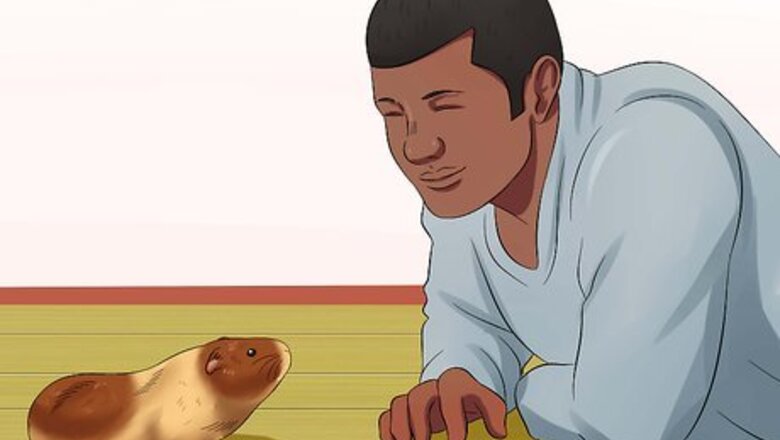
views
X
Research source
Picking Up Your Guinea Pig
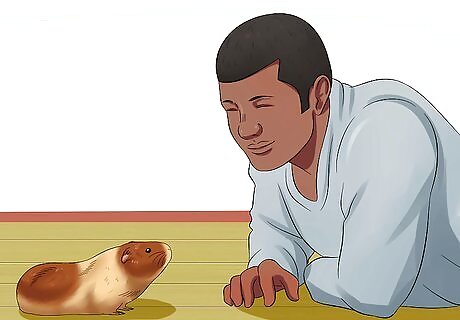
Approach your guinea pig calmly. Animals can sense nervousness in humans. When handling animals of any kind, including guinea pigs, you need to remain calm and confident while around them. If you aren’t able to keep calm for any reason, wait to handle your guinea pig at a time when you are calm. Try talking to your guinea pigs so they aren't startled when you try to pick them up.
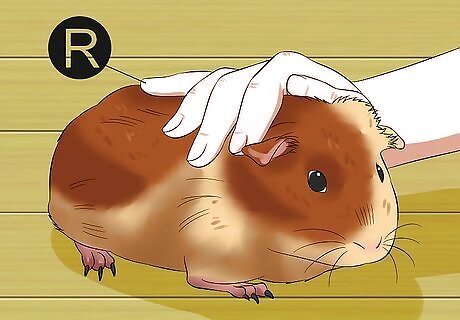
Place your right hand around your guinea pig’s front end. There are two possible ways to place your right hand on your guinea pig’s body. The two methods are outlined here: Method 1 — Place your right hand on top of your guinea pig, across his shoulders. Place your right thumb behind your guinea pig’s front legs. And then place your right fingers in front and behind your guinea pig’s front legs (e.g. one or two fingers in front of his front leg, two to three fingers behind his front leg). Method 2 — Place your right hand under your guinea pig’s chest, near his front legs. Put your index finger in front of your guinea pig’s left front leg, and the rest of your fingers behind his left front leg. Use your index and second fingers like scissors to hold your guinea pig’s left leg still.

Avoid squeezing your right hand. Your hand should be placed on your guinea pig gently but firmly and without applying any pressure. Squeezing your hand may cause your guinea pig to squirm, which in turn may cause him to injure himself.
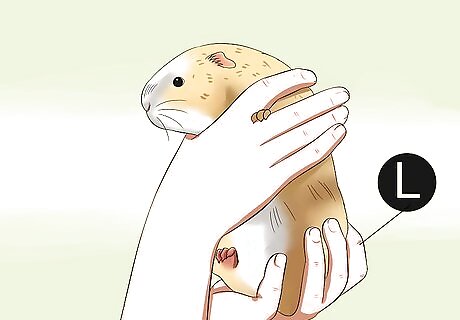
Put your left hand under your guinea pig’s bum. Once you’ve gripped your right hand around the front of your guinea pig, place your left hand behind his bum. Make sure you have his behind fully supported with your left hand.

Lift up your guinea pig horizontally. Lift your right hand up so your guinea pig’s front legs are off the ground. Then support the back end of your guinea pig with your left hand. Make sure your guinea pig’s back legs are always supported, do not allow them to dangle. If your guinea pig struggles when you pick him up, you may need to hold his back legs still with your left hand and fingers.
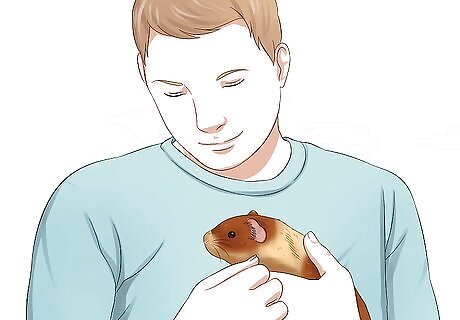
Hold your guinea pig close to your body. Once your guinea pig is off the ground, move your arms so that he’s close to your chest and body. Cuddle your guinea pig against your body while he’s off the ground and you’re moving around. Guinea pigs feel safe and comfortable when they’re either against your body or if they have their feet on the ground.
Handling Your Guinea Pig Regularly
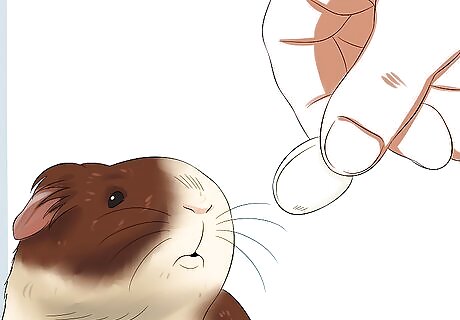
Use treats to entice your guinea pig to like you. When first trying to pick up your guinea pig you need to gain his trust. Start by allowing your guinea pig to sniff your hand and fingers before you touch him. Use treats as incentive for your guinea pig to get closer to you and like you. Treats can include small pieces of fruit like oranges, plums, berries, grapes, bananas, watermelon, or cantaloupe. Treats can also include small pieces of vegetables like basil leaves, turnip greens, bell peppers, romaine lettuce, clover, cilantro, cucumber, tomatoes, celery, corn, dandelions, kale, and chard. The following food can be fed to your guinea pig as a treat, but no more than two times a week: parsley, carrots, and apples.

Handle your guinea pig often. The best way to allow a guinea pig to build a bond with you is to hold him as often as you can. At a minimum you should hold your guinea pig at least once a day.

Be careful when your guinea pig struggles. Guinea pigs, unlike hamsters and gerbils, don’t usually bite when they’re scared. Instead, a guinea pig will squirm and struggle in your hands, hoping you’ll drop him or put him down. If your guinea pig struggles while you’re holding him, be careful not to squeeze him in an attempt to stop the squirming. If your guinea pig decides he wants to bite you, make sure your place your hands where he cannot reach them.

Put your guinea pig into his cage backwards. When you move to put your guinea pig back onto the floor, or into his cage, be aware that he may attempt to jump out of your hands. As jumping out of your hands could injure your guinea pig, a trick you may want to employ is to put your guinea pig down backwards. If your guinea pig can’t see where he’s going, he will be less likely to jump out of your hands.
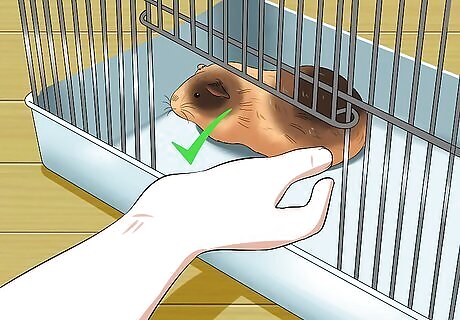
Wait to release your guinea pig when he stops squirming. When attempting to put your guinea pig back into his cage, do not release him from your hands until he stops squirming. Hold your guinea pig firmly, but gently, a few inches off the ground (or floor of the cage) and wait until he stops squirming. Once your guinea pig stops squirming, place his feet on the floor of his cage. Do not release him from your hands until he stops squirming.

Do not hold your guinea pig too long. Even a guinea pig who likes to be held may eventually want to be put down. For example, your guinea pig may need to pee and want to go back into his cage. If your guinea pig starts to struggle and lick your hand, he may want to be put down. If your guinea pig starts to lick your hand, but then settles down again, he may be okay. But if he continues to lick your hand and struggle, you should probably put him back in his cage. On average a guinea pig may only want to be held for 10-20 minutes at a time. If you hold your guinea pig for too long, it is possible he’ll pee or poop on you! You may want to hold your guinea pig on your lap, on top of a towel, in case of an accident.


















Comments
0 comment